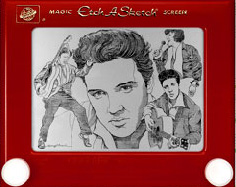 I write a lot about the proliferation of digital production and its effects on concepts of creativity and aesthetic value in established music subcultures – and I have often thought that the resurgence in analog synthesis/retro music technology is connected somehow to the availability of digital production tools to the “masses”. It’s not a phenomenon that is especially unique to music, though. The retro aura is not restricted to the Roland TB-303 or the Moog, but extends to Polaroid cameras (from the 1970s), Super-8 film, and even, I discovered via lorbus, the etcha-sketch.
I write a lot about the proliferation of digital production and its effects on concepts of creativity and aesthetic value in established music subcultures – and I have often thought that the resurgence in analog synthesis/retro music technology is connected somehow to the availability of digital production tools to the “masses”. It’s not a phenomenon that is especially unique to music, though. The retro aura is not restricted to the Roland TB-303 or the Moog, but extends to Polaroid cameras (from the 1970s), Super-8 film, and even, I discovered via lorbus, the etcha-sketch. 
Similarly, photographers are increasingly turning back to obsolescent technologies to fuel their creativity: witness the growing interest in hand-altered polaroid images and pinhole photography.In many ways, the process of producing an etcha-sketch image from a manual sketch is the antithesis of digital imagery: one mistake can mean the sudden death of hours of painstaking work – there is no undo button! And it is my theory that this is precisely the attraction for the artist – the process requires enormous skill, the result is impermanent and unstable, and it is clear that the image has been produced unaided by “technology” – and yet, it requires the use of technology whose obsolescence has been reversed consciously by the artist. That’s what makes it cool, but also what makes it very interesting from a cultural studies point of view.